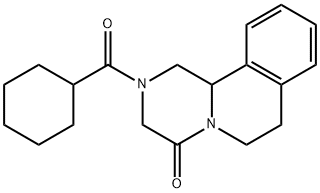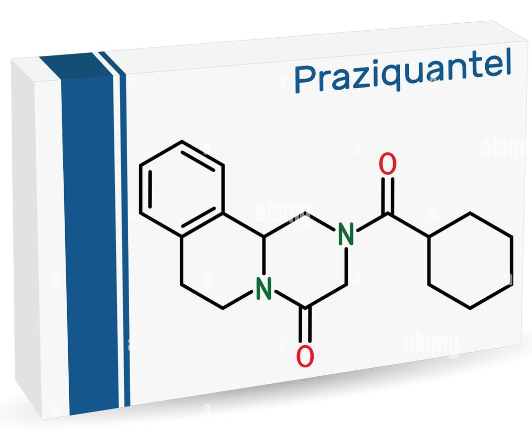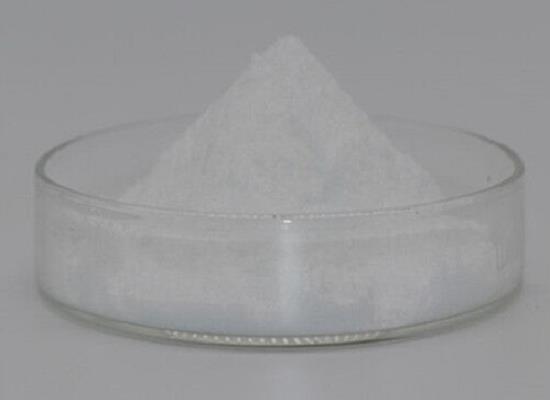Praziquantel: Anthelmintic Activities, Applications in Veterinary Medicine and Mechanism of Action
General Description
Praziquantel is a broad-spectrum anthelmintic effective against trematodes and cestodes in both humans and animals, particularly targeting adult tapeworms. Its primary mechanism of action involves binding to the Schistosoma mansoni TRPMPZQ channel, leading to calcium influx, muscle paralysis, and tegument damage. Praziquantel exists as a racemic mixture, with the (R)-enantiomer being more effective than the (S)-enantiomer. Praziquantel is widely used in veterinary medicine for pets and livestock, available in various formulations, and is often combined with other anthelmintics to enhance efficacy against diverse parasitic infections. Understanding its structure-activity relationships may guide future drug development.
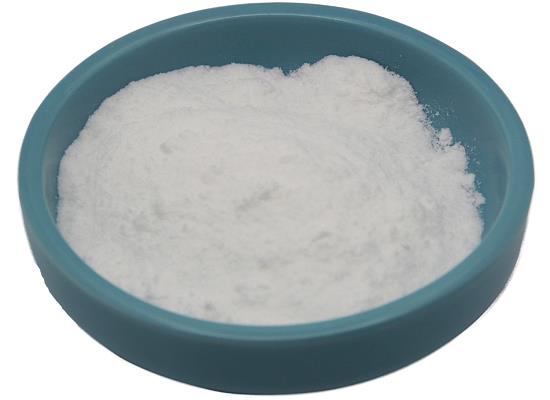
Figure 1. Praziquantel
Anthelmintic Activities
Praziquantel is a broad-spectrum anthelmintic agent effective against a variety of parasitic trematodes and cestodes in both livestock and humans. Its primary action is on adult cestodes, where praziquantel demonstrates high efficacy. However, its effectiveness against larval stages of cestodes can vary. Praziquantel is a racemic mixture of two enantiomers: (R)-praziquantel and (S)-praziquantel. The (R)-enantiomer is notably more active in anthelmintic treatments compared to the (S)-enantiomer, which shows reduced activity. This differential efficacy underscores the importance of understanding the specific actions of praziquantel's enantiomers in developing effective treatments for parasitic infections. 1
Applications in Veterinary Medicine
Praziquantel is a highly effective anthelmintic agent used extensively in veterinary medicine for the treatment of parasitic infections. Since its introduction for veterinary use in 1975 through products such as Droncit® and Cestocur® by Bayer AG, Praziquantel has become a cornerstone in managing parasitic diseases in animals. Praziquantel is particularly effective against cestodes, commonly known as tapeworms, and is available in various formulations to cater to different treatment needs. For pet animals, Praziquantel is offered in tablet form for treating cestode infections and as injectable solutions for more targeted treatments. In cats, spot-on formulations containing Praziquantel provide a convenient and effective method of administration. For livestock, particularly sheep, Cestocur® is available as an oral liquid drench, leveraging Praziquantel's efficacy against tapeworms. In addition to its standalone use, Praziquantel is also a critical component in combination "allwormer" products. These combinations often include other anthelmintics such as pyrantel, fenbendazole, and ivermectin, providing broad-spectrum efficacy against various parasitic species in pets, livestock, and horses. Praziquantel's versatility and effectiveness make it an indispensable tool in veterinary parasitic management. 2
Mechanism of Action
The Primary Target: Schistosoma mansoni's TRPMPZQ Channel
Praziquantel is an essential treatment for schistosomiasis, operating primarily through its action on the Schistosoma mansoni transient receptor potential melastatin channel, specifically identified as Sm.TRPMPZQ. This channel is part of the TRPM subfamily and exhibits broad expression in PZQ-sensitive organisms, indicating its crucial role in the parasite's physiology. When Praziquantel binds to Sm.TRPMPZQ, it activates the channel by engaging its hydrophobic ligand-binding pocket within the voltage-sensor domain. This activation leads to an influx of calcium ions, which disrupts calcium homeostasis in multiple trematode and cestode species, including Schistosoma japonicum and Taenia solium. The resulting biological events include muscle paralysis, tegument changes, and ultimately, parasite death. 3
Structure-Activity Relationships: Insights from Praziquantel Variants
Recent studies have focused on the structure-activity relationships of Praziquantel and its analogs regarding their interaction with Sm.TRPMPZQ. Variations in the cyclohexyl segment of Praziquantel lead to either inactive derivatives or compounds with significantly reduced efficacy. In contrast, modifications of the core structure yielded important insights; only specific fluorinated derivatives and compounds like Epsiprantel demonstrated enhanced activity against Sm.TRPMPZQ. Interestingly, the sequence conservation of amino acids in the binding pocket among various flatworm TRPMPZQ homologs highlights the potential for targeting the channel with new drug candidates. However, mutations, such as a single amino acid substitution in Fasciola hepatica, render Praziquantel ineffective against liver fluke infections, emphasizing the need for additional research towards identifying next-generation antischistosomal drugs. 3
Induction of Physiological Changes: Muscle Contraction and Tegument Damage
Upon activation of Sm.TRPMPZQ by Praziquantel, two significant physiological effects are observed in susceptible parasites. These effects include rapid tetanic contractions of the musculature within seconds and immediate tegument damage, noticeable within 15 minutes of exposure. The calcium ions are vital for these processes; they facilitate the perturbation of the phospholipid membranes of the parasites. Praziquantel induces a transition to hexagonal inverted phases in these membranes, which ultimately disrupts their permeability barrier. This structural change promotes membrane fusion processes and affects enzyme activities associated with the membrane. Notably, the induction of these perturbations appears not to be stereospecific, suggesting that both forms of Praziquantel have similar effects, which broadens the therapeutic potential of the drug, despite its structural variants. 3
References:
[1] CHAI J Y. Praziquantel treatment in trematode and cestode infections: an update.[J]. Infection and Chemotherapy, 2013, 45 1. DOI:10.3947/ic.2013.45.1.32.[2] DR. ANDREAS WAECHTLER. Praziquantel – 50 Years of Research[J]. ChemMedChem, 2023, 18 12. DOI:10.1002/cmdc.202300154.
Related articles And Qustion
See also
Lastest Price from Praziquantel manufacturers

US $100.00-80.00/KG2025-07-17
- CAS:
- 55268-74-1
- Min. Order:
- 1KG
- Purity:
- 99%
- Supply Ability:
- 10000000
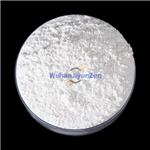
US $5.00-0.50/KG2025-06-13
- CAS:
- 55268-74-1
- Min. Order:
- 0.10000000149011612KG
- Purity:
- 99% hplc
- Supply Ability:
- 5000kg
